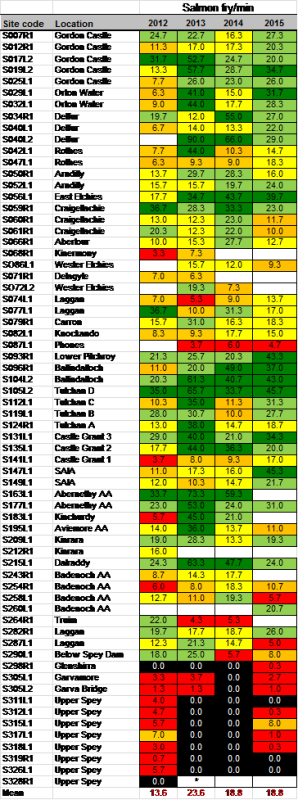It may have been a summer of excellent conditions for angling but the up and down water levels have played havoc with the electrofishing programme, especially in the mainstem. However, with only three sites remaining to do the results are almost complete. It should be noted that the surveys were completed over an extended period this year compared to normal with the median survey date 16 days later than in 2014.
The mainstem salmon fry index surveys comprise 3 minute electrofishing sites, generally in shallow run/riffle with cobble substrate. However, due to habitat distribution and a mix of historic and new locations, the sites cover a range of habitat types. We do this type of survey to try and understand the distribution, and success or otherwise, of salmon spawning along the full length of the Spey mainstem.

Spey mainstem salmon fry index survey 2015. The table is ordered from the bottom of the river to the top with the site code based on 500m sections from the sea. For example Site S264R1, Truim is 132km from the sea.
Th mean number of salmon fry/minute in 2015 was 18.8, exactly the same as recorded in 2014 (it is unlikley that the three remaining sites will alter the average significantly). Considering the low catch of salmon, and the apparent low number of adult fish in the river last year this is a satisfactory result for fry.
After four years of consistent surveying some patterns are emerging;
- From Craigellachie downstream the results are generally above average with all sites in the moderate to excellent categories this year.
- From Craigellachie to Phones the results are generally lower, no doubt a result of the higher gradient here and the restricted availability of spawning gravel.
- The Ballindalloch to Castle Grant area generally supports above average counts although Tulchan D is the only site to be in the excellent category every year.
- The two sites in the Grantown Angling Association water were good this year - better than normal
- Above Grantown the gradient flattens out and suitable survey sites are less frequent. In suitable sites fry counts are often good e.g. Abernethy AA and Dalraddy. The production of juvenile salmon in this area should not be underestimated, on warm, still, days in the summer many parr can be seen rising in the wide, shallow glides prevelent in this area, and it is not as bereft of spawning gravels as it may appear at first glance.
- We introduced a new site this year in the upper river to replace the Truim site which was difficult to access and contained barely enough suitable habitat for 3 minutes surveying. The new site was 2km further downstream with good habitat and is likely to support higher fry counts on average than the site it replaced. Note the lower Badenoch AA site will not be surveyd this year due to access restrictions associated with bridge repairs.
- The two sites closest to Spey Dam produced lower counts than usual this year.
- Above Spey Dam we found fry at 70% of the sites, a big improvement on the last two years. The fry counts here were all in the very low or low categories so whilst some fish must have made it up to spawn last year the counts suggest the spawning stock above the dam was small.
Water levels were on average higher this year than in the two previous years but the relatively stable results support our previous conclusion that this survey technique is not as sensitive to water levels as it may appear (H&S being an equally important consideration for mainstem surveys).
Whilst some of the survey dates were later than normal we have surveyed some sites later in the past but never have we found mainstem sites where the average size of the fry was over 7omm in August. At the Boat o’Brig site the largest salmon fry were 86mm; a size and date combination with the potential to produce one year old smolts next year.
Why such large fry you may ask as it has certainly not been a year with high water temperatures which would promote growth? The relatively low numbers of parr recorded this year is likely to be a contributing factor, as could the medium water levels with high wetted areas of habitat available. The presence of high densities of larger parr is likely to depress the feeding activity, and therefore growth of, the smaller fry but in years when the parr counts are lower the absence of “despotic behaviour” by the parr could allow more of the new season fry to survive and thrive.
Again we can say that salmon fry were present at every site below Spey Dam. Above Spey Dam the juvenile salmon population continues to be too low and we can only conclude the adult spawning stock in that part of the river is not in a healthy state.
The post Spey mainstem salmon fry surveys 2015 appeared first on Spey Fishery Board.
Spey Fishery Board
